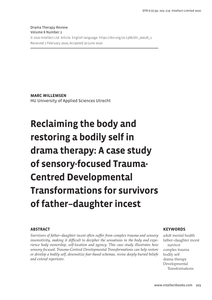Survivors of father–daughter incest often suffer from complex trauma and sensory insensitivity, making it difficult to decipher the sensations in the body and experience body ownership, self-location and agency. This case study illustrates how sensory focused, Trauma-Centred Developmental Transformations can help restore or develop a bodily self, desensitize fear-based schemas, revise deeply buried beliefs and extend repertoire.
DOCUMENT

In this project we take a look at the laws and regulations surrounding data collection using sensors in assistive technology and the literature on concerns of people about this technology. We also look into the Smart Teddy device and how it operates. An analysis required by the General Data Protection Regulation (GDPR) [5] will reveal the risks in terms of privacy and security in this project and how to mitigate them. https://nl.linkedin.com/in/haniers
MULTIFILE

Europeans are living longer than ever in history, because of the economic growth and advances in hygiene and health care. Today, average life expectancy is over 80, and by 2020 around 25% of the population will be over 65. The increasing group of older people poses great challenges in terms of creating suitable living environments and appropriate housing facilities. The physical indoor environment plays an important role in creating fitting, comfortable and healthy domestic spaces. Our senses are the primary interface with the built environment. With biological ageing, a number of sensory changes occur as a result of the intrinsic ageing process in sensory organs and their association with the nervous system. These changes can in turn change the way we perceive the environment around us. It is important to understand these changes when designing for older occupants, for instance, care homes, hospitals and private homes, as well as office spaces given the developments in the domain of staying active at work until older age.
MULTIFILE
